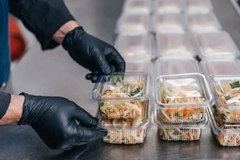Controlling calories and carbon footprints: Snack packagers rise to dietary and environmental challenges

13 Sep 2023 --- Snack packaging continues to grow globally, with Innova Market Insights marking a 2% year-over-year growth. But consumer demands for dietary control are shaping how the industry designs new products, and with tightening environmental sustainability legislation, packagers must now meet sets of changing and often conflicting requirements.
Lorenzo Birro, key account manager at Cama Group, explains that calories and portion control affect how snack packaging develops.
“New bars rich in proteins need a certain dimension to fulfill a number of calories. This might affect line speeds, packaging configurations and design of machines and lines,” he says.
“The other trend is about multipacks of small portions, both mono-flavor or multiple-flavor, to satisfy the desire of consumers to vary the taste at certain moments of the day.”
 Lorenzo Birro, key account manager at Cama Group.Marcel Veenstra, marketing and communications director at Sealpac, also says the demand for portion packaging is an important factor in combating food waste and related GHG emissions.
Lorenzo Birro, key account manager at Cama Group.Marcel Veenstra, marketing and communications director at Sealpac, also says the demand for portion packaging is an important factor in combating food waste and related GHG emissions.
“We see a strong demand for snacks in portion packaging. An important reason why consumers throw away food is the mismatch between the amount of food inside the pack compared to the actual need of the consumer,” he explains.
“Especially with the number of single-person households and smaller families growing across the globe, this issue has become ever more evident. Snacks in portion packs assist these households in reducing food waste.”
Consistency, sustainability
Birro emphasizes that packaging needs to be consistent with brand image, meaning that it needs to deliver environmental sustainability and functionality to consumers while also adding value on the shelf to the distribution channels, including online sales.
The main challenges in improving the environmental sustainability of snack packs lie in adapting existing equipment to smaller counts that equal higher speeds, which is only sometimes feasible, he says.
“Making machinery perform while having to handle primary packs with different characteristics in terms of rigidity (or flexibility) of the primary pack, and dimensions,” explains Birro.
“Let’s take an example: A customer used to pack a tray of cookies with a biaxially-oriented PP (BOPP)-based flexible material. Over the years, the shipper was optimized to save unnecessary cardboard and/or to suit pallet dimensions and logistics requirements better. BOPP is replaced by paper-based materials, which cannot fit with the same case dimensions because of their rigidity and unlikelihood of being compressed. This requires new designs and solutions.”.
Other examples include the switch from a laminated structure of the primary packaging to a monomaterial, which, despite potentially being more environmentally friendly, poses challenges in terms of packaging rigidity.
Vegetarian trends  Plant-based nugget snacks by Sealpac.Veenstra highlights that resource conservation in snack packaging, like any other food segment, pertains to both the packaging and the product.
Plant-based nugget snacks by Sealpac.Veenstra highlights that resource conservation in snack packaging, like any other food segment, pertains to both the packaging and the product.
“Sustainable solutions increasingly rely on monomaterials for improved recycling, are characterized by reduced plastic content, or process alternative materials such as paper into safe and attractive packaging,” he says.
“Also, more people are either consistently vegetarian or vegan or have become flexitarian, meaning that they occasionally and consciously decide not to eat meat products. This is also due to contemporary plant-based alternatives, which come so close to their meat-based role models in both taste and consistency that refraining from meat no longer has to go hand in hand with a significant decline in enjoyment.”
“It is clear that the target group for alternative meat products highly values a sustainable packaging design to go along with it. A similar trend can be seen with seafood and seafood-based snacks,” Veenstra continues.
Policy changes
To drive improvements in snack packaging designs, governments and policymakers must make necessary interventions and changes, says Birro.
“The topic of achieving environmental goals is wide and could suffer distractions coming from influencers, historical periods and specific happenings. To be effective, policies and rules should be consistent, uniform across nations and scientifically based.”
“The driver of declaring a packaging ‘environmentally sustainable’ should be the LCA assessment. This is because it bases itself on scientific data and objective analysis. It has to be coupled with the boost to adopt the best-in-class practices of collection and recycling – on which Italy is an indisputable leader,” he says.
However, a recent study review by Eunomia Research and Consulting demonstrated that LCA designs and methodologies typically produce biased and suboptimal results.
Nevertheless, Birro says the collection and recycling practices “need to become part of our culture.”
“Policymakers should work on developing this culture starting from schools, where it can be thought that the most effective recycling begins from throwing the packaging in the right bin, to follow the dedicated recycling stream. Equally important is to clarify and develop laws that manage the end of waste and for which applications it can be used again, widening the actual spectrum.”
By Louis Gore-Langton











